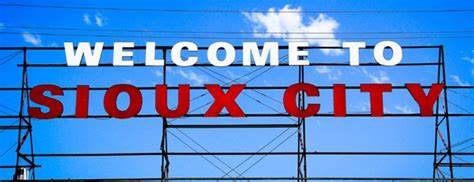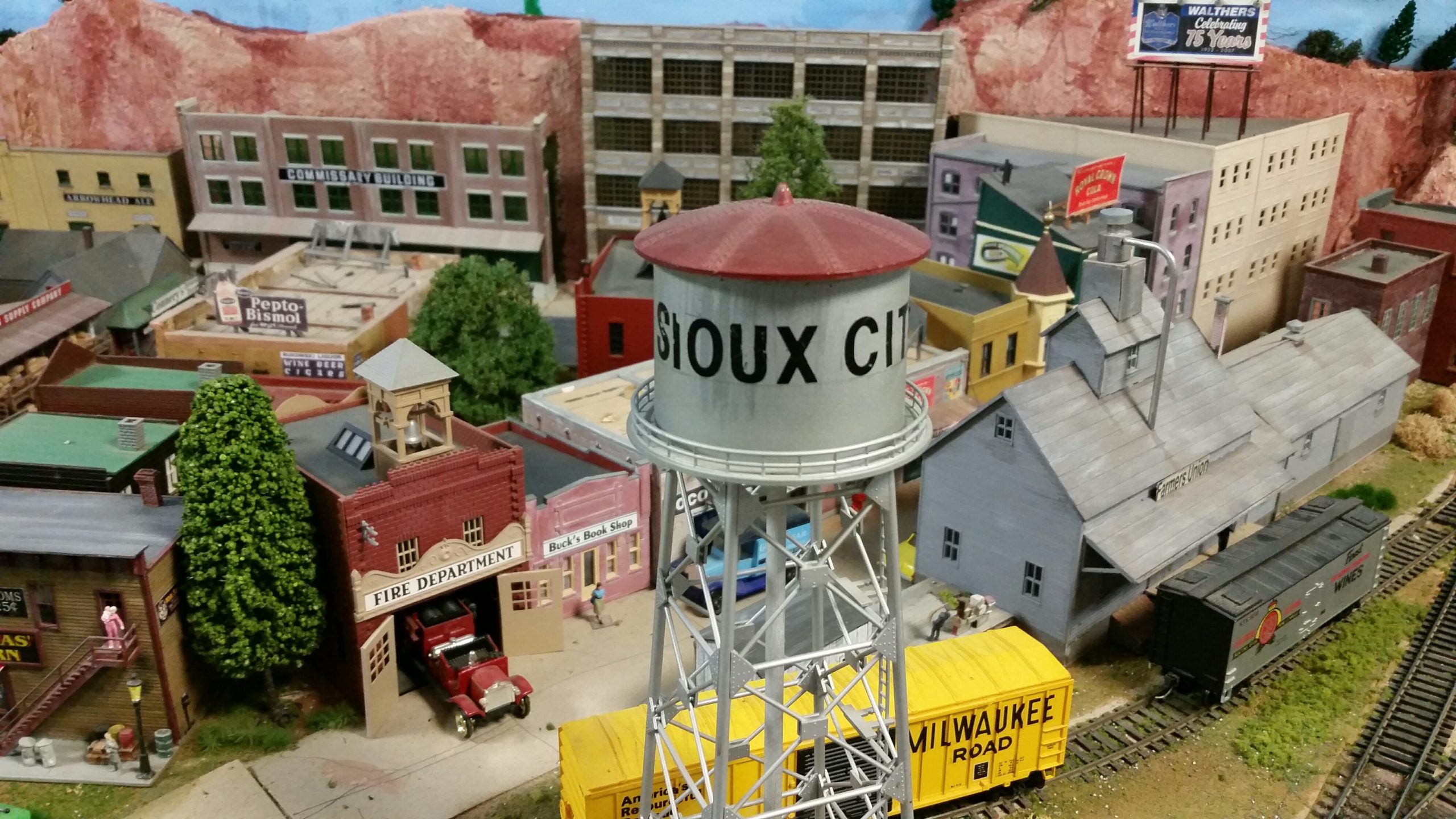In our previous posts we have vaguely mentioned the Sioux City railroads and their impact on helping build not only the Corn Palaces and the stockyards, but it has also provided us with a beautifully
In our previous posts we have vaguely mentioned the Sioux City railroads and their impact on helping build not only the Corn Palaces and the stockyards, but it has also provided us with a beautifully restored and maintained Railroad Museum. Today, however, we are going to delve further into the importance railways are to the infrastructure of Sioux City.
Knowing I wanted to write about the railroads, I made my way over to the Lewis and Clark Interpretive Center, and thumbed through a couple historical books on Sioux City. There’s a plethora of information in this tiny library inside the Interpretive Center, and if you ever get a chance to do your own research on Sioux City, you’ll find this resource very useful. You’ll also notice, the black and white photos shown in this post were actually taken during my visit here, while I read up on Sioux City history.
The railroad comes to Sioux City!
By the time the first train rolled into Sioux City in 1868, railways had been a common form of transportation out east for nearly 40 years already. Having the railroad come to Sioux City was undoubtedly existential to our economy’s health and growth. This meant more trade and manufacturing companies would consider Sioux City when transporting goods, and even build here.
The first railway lines to be laid were Pacific. This would connect us down through Missouri Valley and back East to Chicago. Soon shipping industries were rapidly sending workers to build and create jobs here in Sioux City. In fact, our population grew from 1,380 to over 4,000 in just two years!
Elevated railway
With all this expansion, Sioux City became a hub of railway traffic, but did you know we once had an elevated railway? During the 1880s businessman and promoter Arthur Garretson owned property in Morningside, and fancied a convenient method of transportation for his fellow neighbors. This form of transportation would have to allow people to bypass busy streets and avoid the never-ending train traffic.
Welcome the elevated railway! Construction began in 1890, starting at the intersection of 3rd and Jones and leading all the way to Leech Avenue, and rising 22 feet above the ground it spanned a total of two miles. Travelers would pay .05 cent fee, and residents looking to purchase land in Morningside were offered an incentive: free yearly railway membership if you purchase land in Morningside. This undoubtedly helped further the growth and expansion of the Morningside neighborhood. And today it remains one of the fastest growing areas of Sioux City.
1st in the world?!
If you are amazed to learn that we once had an elevated railway, then you will be further impressed to know it was one of only three in the world at the time! And after it was powered by electricity, it became the first electric railway in the world!
Street cars and cable cars
Along with electrifying the elevated railway, street cars were also electrified in 1890. Previously, in 1884, horse drawn street cars would take patrons from 4th and Court to West 7th and Panoah. But now with the electric street cars, patrons could travel all over Sioux City, and by 1891 we had 66 cars operating on 16 miles of track. Named The Sioux City Street Railway Company, these tracks were owned by James and Frank Peavey, whose names you may recognize when we looked at the Peavey Grand Opera house last month.
There was a competing line, however, owned by John Peirce and D.T. Hedges, and called The Sioux City Cable Railway Company. You may recognize Peirce’s name from the Mansion on Jackson Street, which used to house the Sioux City Public Museum. Pierce and Hedges sought to build on Jackson Street, settle the north side of town, and developed their street cable car line in 1888. One short year later, cars were running up and down Jackson Street, bringing convenient transportation from 3rd and Jackson all the way to Peirce’s mansion on 29th and Jackson, and later expanded to 41st Street.
As a popular form of public transportation, Sioux City’s street cars and cable cars allowed residents to get from one place to the other conveniently and quickly without having to drive in an automobile, and bottleneck the streets. Plus, not everyone could afford an automobile, so riding in street cars and cable cars was one of the most economical and affordable transportation options available at the time. Additionally, by 1892 there were five competing lines, plus the elevated railway, making for an exciting time to be alive in Sioux City.
Chicago El
In fact, after coming to witness Sioux City’s technological advancement, investors from Chicago were so impressed with our elevated railway, they took the ideas they learned here, and built their own. Today, if you ride the Chicago El, you are witnessing the fruition of what could have been here in Sioux City, since Chicago’s elevated railway is directly based off of Sioux City’s innovative design.
the financial panic of 1893
So, what happened? Why don’t we have miles and miles of elevated railways and street cars traversing every major intersection in all of Siouxland today? Well, there were plans to expand, but they were abandoned when The Financial Panic of 1893 forced a multitude of businesses to file bankruptcy. This panic nearly collapsed the railroad industry, forcing banks to seize financing of future railroad endeavors, thus halting the expansion of our very own railways here in Sioux City.
Larger cities were able to absorb this financial strain, but we were not. By the early 1900s, railway services had ceased, and what had looked to be promising in 1890, had been completely demolished only ten years later.
back on top
Today, Sioux City is still a vital artery within the railroad transport system. Hundreds of train cars disembark daily to and from interchanges, cargo is shipped in and out of Sioux City, and train whistles can be heard nightly. Our train traffic is obvious when it forces commuters to endure five to ten minutes of train crossings, however, as many have said before, “Busy business, is good business”, and that is true here. Sioux City has been experiencing some exciting growth lately, and with the creativity of local business owners, we are on the cusp of innovation and imagination. We were one of the first in the world to build an elevated railway, we are known nationally for producing Jolly Time Popcorn, and we had the world’s first Corn Palace. There is much more growth and development left to achieve for this modest river city, and I’m excited to witness it in the months and years to come. We have an incredibly strong foundation, and we can build back up what we once lost so many years ago. We did it once, we can do it again!
If you’d like more reading material on the elevated railway, check out the Sioux City’s History page and History and Culture by Bicycle blog post: http://www.siouxcityhistory.org/transportation/114-elevated-railway
http://historyculturebybicycle.blogspot.com/2013/02/sioux-city-elevated-railway.html
Sioux City’s History page also has an article about our street cars here: http://www.siouxcityhistory.org/transportation/113-cable-a-street-cars
And finally, if you’d like to see what some of these street cars looked like, and even our elevated railways, the Sioux City Journal has an impressive collection of vintage photography here: https://siouxcityjournal.com/blogs/siouxland_history/transportation/look-back-sioux-city-street-cars/collection_d7e4aafd-e8f0-5f38-ae09-a4ea71ab5d77.html#2


















